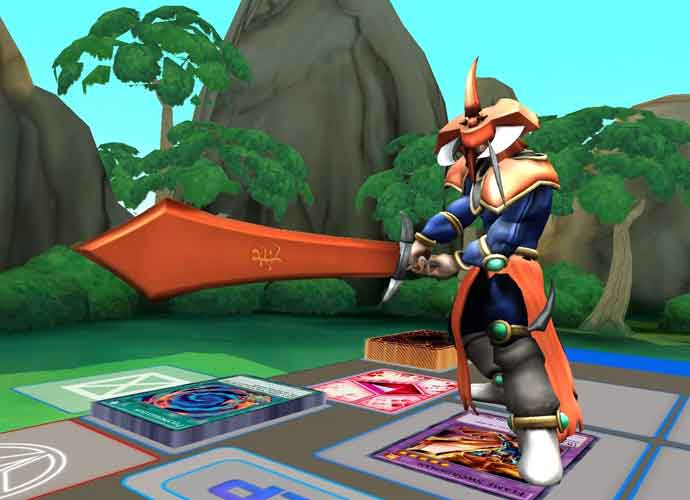‘Yu-Gi-Oh! Legacy Of The Duelist’ Game Review: Fun For Die-Hard Fans

2.5/5
IT’S TIME TO D-D-D-D-D-D-D-D-D-D-D– play a video game. After the mildly successful Yu-Gi-Oh! 5 Ds: Decade Duels, Konami must have realized that maybe they should make bank on one of their most productive series rather than simply destroying the series and pissing off Guillermo del Toro. Yu-Gi-Oh Legacy of the Duelist showcases what makes this card game one of the most successful in the world.
Around the same time as Pokemon got its animated series, Yu-Gi-Oh! premiered, promoting their card game through a Japanese anime about Egyptian gods. Yes, it’s a very worldly piece of entertainment. The object of the game is to summon monsters with thousands of attack points to bring your opponents 8000 lifepoint total to zero around a set of rules. This being said, the rules can easily be bent to your advantage through decks with themes, effect monsters magic cards, trap cards, Exodia, special summons, fusion summons, sychro summons, xyz summons, pendulum monsters, and, most importantly, v-cards. The point is, this incredibly complicated game provides the player with thousands of ways to win each match.
Perhaps the most interesting part of this game is how there is a campaign mode, allowing you to play through some of the most iconic parts of the five-story series. Each story section begins with a tutorial level, teaching you the basics of the game, before letting you get down and dirty with your deck.
Unlike Decade Duels, you aren’t given a specific, mediocre deck that you are forced to use for the entirety of the game. Rather, you are expected to use a different deck for each chapter based on different sections of the original story. Certain sections are skipped, as either certain season’s cards break the rules, such as the Seal of Orichalcos, or are impossible to include in the standard game without extra programming effort, such as Dungeon Dice Monsters, dueling in cyberspace, the main character is evil now with game-breaking powers, and, of course, card games on motorcycles. This being said, the stories are told fairly well, with memorable lines of dialogue included and decks that have most of the cards the characters used in the show.
You are also no longer given random cards once you win a duel, you are given points to buy packs with several themes, nearly always character-focused. Themes are important for a Yu-Gi-Oh! deck, so this allows for improvement of a given type rather than playing with a general deck and praying for a good card to come along once every 25 duels. There are several modes additional to campaign mode, such as multiplayer mode, a challenge mode for each deck, and even an option to play as the opposition of each campaign duel.
Similar to Decade Duels, however, are loads of disappointments. The unquestionably stellar soundtrack of Decade Duels has been replaced by a few lacking songs, if you can even call them songs. There is no voice acting from the impressive, recognizable VAs such as Dan Green or Eric Stuart, even though a recently released app, Yu-Gi-Oh! Duel Links, has the voice cast of the original Yu-Gi-Oh! series. The CGI models are forced, slow the speed of battle, and aren’t even remotely impressive. For some reason, pendulum monsters are included, yet the campaign only includes a tutorial. The sixth part of Yu-Gi-Oh! was announced fairly recently, as Arc-V is ending September 2017, so there’s no reason not to include an entire story when all of the cards needed to program the deck are literally all there.
This being said, nothing is worse than some of the decks you are forced to use in story mode. These are without a doubt some of the worst decks I have ever seen in my entire life. Decks based on tribute summons giving you nothing to sacrifice? Check. Decks that oppose magic and trap based decks yet give you nothing to destroy them with? Check. A deck forcing you to summon something to win, yet giving you only one way to summon it through 3 cards out of 40? Check.
The game’s structure shouldn’t function on leaving you to fight against your own deck, it should let you work with what you have to learn the game You can always switch to an infinitely better deck you have on the side, but it just doesn’t feel the same. Some decks are truly fun to use and would make others very interested in playing the game, and considering the physical cards required to make a competitively viable deck can go from $300 to $1500, this would give Konami a massive boost in revenue. Additionally, when a trap or magic card can be used at any time, pop-ups occur; some of the best cards in the game are equivalent to a computer virus. Considering this game isn’t the first impression customers will have to the franchise, these finer details should have been the focus in order to get casual fans to buy more cards.
Again, if you’re not into Yu-Gi-Oh! in the first place, you wont be interested in this game. For those who are interested in playing this intricate, complex, over-the-top card game, this game is only $20. I personally think this is a fun game, but most people probably wont unless they’ve been exposed to the card game or show beforehand. It made me want to watch the anime and get a deck, but I’m not everyone. Yu-Gi-Oh! Legacy of the Duelist would be graded C overall, as the mistakes it makes would result in at least 5Ds! Haha! More nerd jokes coming up in the next review!
RELATED ARTICLES
Get the most-revealing celebrity conversations with the uInterview podcast!







Leave a comment